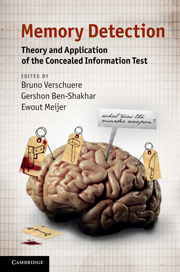Book contents
- Frontmatter
- Contents
- List of figures
- List of tables
- Notes on contributors
- Acknowledgments
- Part I Introduction
- Part II The laboratory: theoretical and empirical foundations of the Concealed Information Test
- Part III Field applications of concealed information detection: promises and perils
- 8 Limitations of the Concealed Information Test in criminal cases
- 9 Validity of the Concealed Information Test in realistic contexts
- 10 Leakage of information to innocent suspects
- 11 Countermeasures
- 12 Psychopathy and the detection of concealed information
- 13 Clinical applications of the Concealed Information Test
- 14 Daily application of the Concealed Information Test: Japan
- 15 The Concealed Information Test in the courtroom: legal aspects
- Part IV Conclusions
- Index
- References
15 - The Concealed Information Test in the courtroom: legal aspects
Published online by Cambridge University Press: 05 June 2012
- Frontmatter
- Contents
- List of figures
- List of tables
- Notes on contributors
- Acknowledgments
- Part I Introduction
- Part II The laboratory: theoretical and empirical foundations of the Concealed Information Test
- Part III Field applications of concealed information detection: promises and perils
- 8 Limitations of the Concealed Information Test in criminal cases
- 9 Validity of the Concealed Information Test in realistic contexts
- 10 Leakage of information to innocent suspects
- 11 Countermeasures
- 12 Psychopathy and the detection of concealed information
- 13 Clinical applications of the Concealed Information Test
- 14 Daily application of the Concealed Information Test: Japan
- 15 The Concealed Information Test in the courtroom: legal aspects
- Part IV Conclusions
- Index
- References
Summary
Overview: This chapter focuses on the admissibility of evidence based on CIT outcomes in criminal trials. We adopted the criteria formulated in Daubert v. Merrell Dow Pharmaceuticals Inc. (1993) to evaluate admissibility. The literature on polygraph admissibility, which revolved only on the CQT, suggests that this technique does not meet the Daubert criteria. An examination of the CIT by these criteria reveals that although the current CIT research body suggests that it has a good potential for meeting the Daubert criteria, it is premature to recommend at this time that CIT outcomes will be used as admissible evidence in criminal trials. The main reason for this reservation is that the bulk of the CIT research is an experimental laboratory research and very little information exists today on CIT validity in the realistic forensic context. We recommend that future CIT research will examine the validity of this technique in realistic settings, or at least rely on laboratory experiments that better approximate realistic conditions.
Introduction
The question of whether polygraph tests' results should be used as admissible evidence in criminal courts is almost as ancient as polygraph testing itself. The first attempt to introduce polygraph test results into the US courtroom was made as early as 1923 (Frye v. United States). In the Frye case, the court rejected the polygraph testimony, but more importantly the ruling in this case has become a precedent for the admissibility of all scientific evidence in US courts for many years to come.
- Type
- Chapter
- Information
- Memory DetectionTheory and Application of the Concealed Information Test, pp. 276 - 290Publisher: Cambridge University PressPrint publication year: 2011
References
- 5
- Cited by



